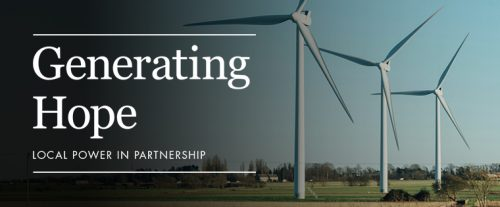Power and Prosperity: Unlocking Local Investment for Housing and Energy Futures
- truthaboutlocalgov
- Aug 12
- 7 min read
In the latest episode of The Truth About Local Government, I had the pleasure of speaking with Joe Fyans, Head of Research at Localis, about two groundbreaking reports that could reshape the future of local investment in Britain. These reports New Stable and Generating Hope offer a bold vision for how local government pension schemes and energy strategies can be leveraged to address two of the most pressing challenges facing our communities: the housing crisis and the transition to clean energy. Our conversation explored the potential for local authorities to take a more proactive role in unlocking financial and strategic resources that are already within their grasp. These publications are not just policy documents they are calls to action, urging councils, fund managers, and central government to rethink how we invest in place, people, and prosperity.

At the heart of New Stable lies a compelling and timely proposition: that the surplus held within the Local Government Pension Scheme (LGPS) could be strategically deployed to fund the development of genuinely affordable housing. This is not a speculative idea it’s grounded in hard numbers and sound investment logic.
As Joe explained during our discussion:
“Total assets of £392 billion… the investment characteristics of a pension fund slow, patient capital, low but stable yield are very much in line with investment in affordable housing.”
The LGPS is currently estimated to be funded at around 125.5% on a low-risk basis. This surplus represents a vast pool of capital that could be redirected towards housing projects that not only deliver financial returns but also generate significant social value. Yet, despite its potential, this resource remains largely untapped.
Why? Joe identified two primary barriers:
Lack of explicit guidelines and incentives:
“We don’t have very explicit guidelines or incentives for councils to add LGPS funds to work on this.”Without clear direction from central government, many councils are hesitant to explore this avenue, fearing regulatory or fiduciary repercussions.

Institutional capacity and risk perception:
“Councils only have so much resource to get into novel models of funding… and that also ties in with risk perception.” Many local authorities lack the internal expertise or bandwidth to develop and manage innovative investment models, particularly in the face of ongoing financial pressures and staffing constraints.
Appropriate Investment Vehicles: Making It Work Locally
To overcome these barriers, the report advocates for the creation of “appropriate investment vehicles” that can channel pension capital into housing in a structured and locally responsive way. Joe elaborated:
“We’re talking about structured partnerships and joint ventures, special purpose vehicles… fitting into long-term strategic plans within a supportive framework of governance.”
These vehicles are not theoretical constructs they already exist in various forms at the national level. However, the challenge is to adapt and scale them for local contexts. This means embedding them within local masterplans, aligning them with community needs, and involving key partners such as housing associations, registered providers, and pension fund experts. The goal is to create delivery mechanisms that are not only financially viable but also socially impactful. By doing so, councils can ensure that investment decisions reflect both fiduciary responsibility and public purpose.
Balancing Fiduciary Duty with Social Value
One of the most nuanced and thought-provoking parts of our conversation centred on the concept of fiduciary duty. Traditionally, pension fund managers are expected to prioritise financial returns above all else. But Joe argued for a more expansive interpretation one that includes social and economic outcomes as legitimate measures of success.
“Central government should provide much more explicit guidance… that local investment in well-structured projects is compatible with their responsibilities.”
He suggested that central government could go further by distinguishing between required assets and surplus assets within pension funds, allowing for more targeted investment strategies. Moreover, he called for the adoption of alternative metrics such as social return on investment and place-based impact investing, which can help quantify the broader benefits of local investment.
This led to a moment of reflection during the podcast:
“What kind of success is your success and what kind of success is the fund’s success?”
Success, in this context, is not a one-size-fits-all concept. For councils, success might mean reducing homelessness, improving public health, or stimulating local economies. For pension funds, it might mean stable returns and long-term sustainability. The challenge and the opportunity is to find a balance that honours both. This philosophical shift is essential if councils are to align pension investments with their broader social missions. It requires courage, clarity, and collaboration across sectors. But if done well, it could unlock a new era of place-based investment that delivers lasting value for communities across the UK.

Shifting focus to the second report, Generating Hope, our conversation turned to the critical role local authorities can play in delivering clean energy solutions through the Local Power Plan an integral component of the broader Great British Energy agenda. This report seeks to reposition councils not just as facilitators, but as central actors in the UK’s energy transition.
Joe Fyans summarised the ambition succinctly:
“It’s a broad term for the local element… our report was trying to put local government back front and centre in this agenda as deliverers of clean power.”
The Local Power Plan, as outlined in the founding documents of GB Energy, places emphasis on community energy and local authority-led initiatives. However, the report from Localis argues for a more structured and empowered role for councils, ensuring they are equipped to lead the charge in clean energy delivery, rather than being relegated to the sidelines.
Barriers to Local Energy Delivery
Despite the promise and potential of local energy projects, councils face a range of significant and persistent barriers that hinder progress. These challenges are multifaceted and echo many of the issues identified in the housing investment space.
Joe outlined three core categories of obstacles:
Technical limitations:
“Grid infrastructure is not prepared… significant skills gaps across planning, legal, procurement.”
The existing energy grid is not fit for purpose when it comes to accommodating decentralised renewable energy generation. Moreover, councils often lack the technical expertise required to navigate complex energy projects, from legal frameworks to procurement processes.
Financial constraints:
“High upfront costs… heightened by increased interest rates and investor perception of risk.” Renewable energy projects typically require substantial initial investment, which can be difficult to secure especially in an environment of rising interest rates and cautious private sector investors. This financial uncertainty can stall or derail promising initiatives.
Political and public resistance:
“Public opposition… inconsistent approach from central government… fragmented funding streams.” Local developments, particularly those involving large-scale energy infrastructure, often face opposition from residents. This is compounded by a lack of coherent national policy, piecemeal funding arrangements, and misaligned priorities between central and local government. These barriers reinforce the need for strategic partnerships, robust planning, and a clear policy framework to support local authorities in their energy ambitions.
Public-Private Partnerships: Bridging the Gap
One of the most promising solutions to these challenges lies in the development of long-term, flexible public-private partnerships. Joe pointed to Coventry’s strategic energy plan as a leading example:
“It can help with technical challenges… fill skills gaps… and depending on who your partner is, they have an investment case.”
Such partnerships allow councils to tap into the expertise, resources, and innovation of the private sector, while retaining control over the social and environmental outcomes of energy projects. The key, however, is ensuring that these collaborations are rooted in community benefit and aligned with local priorities.

As Joe emphasised:
“It’s all about local government as the interface between a private public party and community.”
This means involving residents in decision-making, ensuring transparency in procurement, and delivering tangible social value whether through job creation, reduced energy bills, or improved infrastructure.
The Energy Trilemma: Sustainability, Security, Affordability
A central theme in Generating Hope is the “energy trilemma” a concept that captures the delicate balance between three essential goals: sustainability, security, and affordability. It’s a phrase that resonated deeply with me during our conversation.
Joe broke it down as follows:
Sustainability:
“Energy efficiency programmes can tackle fuel poverty.”Local authorities have the ability to implement retrofit schemes and energy-saving initiatives that directly reduce household energy costs and carbon emissions.
Security:
“Increasing domestic capacity reduces reliance on foreign fuel.” By investing in local energy generation, councils can help insulate the UK from global energy shocks and geopolitical instability a concern that has only grown in recent years.
Affordability:
“Investment in the net zero economy creates jobs and infrastructure.”
Clean energy projects are not just environmentally sound they’re economically strategic. They stimulate local economies, create employment opportunities, and lay the groundwork for future development. In light of global events from the war in Ukraine to tensions in the Middle East Joe underscored the urgency of building domestic energy resilience:
“Every major economic shock since the 60s has been linked to the global market… energy is a really good one to start with.”
This is not just a technical issue it’s a matter of national security, economic stability, and moral responsibility.

Policy Recommendations: What Needs to Change
To unlock the full potential of local energy delivery, Generating Hope outlines several key policy recommendations that could transform the landscape:
Statutory local area energy planning:
“Similar to a local plan… to integrate renewable generation and sustainability.” Councils need formal planning frameworks that embed energy considerations into every aspect of local development. This would ensure that housing, transport, and infrastructure projects are aligned with net zero goals.
Consolidated funding streams:
“We’re getting there… but can always do more.” Fragmented and competitive funding pots create inefficiencies and uncertainty. A more streamlined approach would enable councils to plan strategically and deliver at scale.
Investment in local skills programmes:
“If we don’t invest in people, GB Energy will fall down at the delivery end.” The energy transition will only succeed if local authorities have the right people in place. This means investing in training, education, and capacity-building across the public sector.
As I reflected during the podcast:
“Wouldn’t it be beautiful if the people that live there could benefit from the powers of devolution we’re offering?”
Devolution must be more than a transfer of powers it must be a transfer of opportunity. Local energy projects offer a chance to regenerate communities, empower residents, and build a more equitable future.
Conclusion: A Call to Action
New Stable and Generating Hope are more than just reports they are blueprints for a new era of local leadership. They challenge us to rethink how we use public assets, how we define success, and how we empower communities to shape their own futures.
Whether it’s unlocking pension surpluses for housing or delivering clean energy through strategic partnerships, the message is clear: local government has the tools, the insight, and the ambition to lead. What’s needed now is the support, the clarity, and the courage to act. To explore the reports further, visit localis.org.uk. And if you’re ready to reflect, ask yourself:
“What interests are our interests?”





